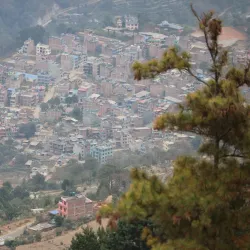Crime and Pollution in Baglung
The following data and statistics on crime, pollution, and overall safety in Baglung are derived from a combination of trusted public sources and insights gathered from over 1 user contributions.
This comprehensive approach helps provide a balanced view of the city's crime rates, environmental concerns, air quality, and public safety. By aggregating information from government reports, environmental studies, and direct feedback from residents, we aim offer an up-to-date and thorough analysis of key factors impacting quality of life in Baglung.
Crime Data in Baglung
Crime Perception and Concerns
In 2024, Baglung, Nepal, is perceived as a safe haven with very low crime rates. This perception is strongly supported by the data, showing minimal concerns about various forms of crime.
Residents of Baglung experience a high sense of personal safety, both by day and night, reflecting its reputation as a tranquil and peaceful community.
Some notable concerns include:
- Property Crimes - Property crimes in Baglung are reported to be minimal, with residents expressing a strong sense of security regarding their personal belongings and property.
- Drug-Related Issues - The concern about drug-related activities in Baglung is relatively low, indicating that drug issues are not a significant problem within this community.
- Violent Crimes - There is a negligible concern about violent crimes in Baglung, with very few residents expressing worries about such incidents occurring in their surroundings.
- Public Safety - Public safety in Baglung is robust, with surveys showing people feel particularly safe both during the day and at night, leading to a comfortable living environment for its residents.
Crime Trends and Safety
- Rising Crime Concerns - Concerns about rising crime are virtually nonexistent in Baglung. On the contrary, the perception is that crime is decreasing, contributing to the overall sense of security in the area.
- Specific Fears - Aside from minimal concerns about specific crimes, fears based on racial, ethnic, or religious discrimination are also non-existent, highlighting Baglung's inclusive and accepting community.
Summary of Crime in Baglung
Baglung remains a remarkably safe city with few crime-related issues, thanks in part to community cohesion and effective local governance. Continued efforts to maintain this low crime level would serve to enhance residents' quality of life even further.
Crime Rankings
The crime ranking by city for Nepal is based on a continuously updated index, incorporating data up to 36 months old and calculated twice a year. Cities are ranked on a scale from "very low" to "very high" crime levels, with safety being the inverse, where a high safety index indicates a safer city.
Pollution Data in Baglung
Air Quality and Pollution Levels
Baglung's air quality is characterized as moderate, with limited concerns reported regarding typical pollutants like PM2.5 and PM10.
Despite the moderate air quality, public perception indicates an unremarkable performance in addressing broader pollution challenges not directly affecting immediate livability.
- PM2.5 (Fine Particulate Matter) - The PM2.5 levels in Baglung are reported to be virtually negligible, suggesting a low presence of fine particles that could adversely affect health.
- PM10 (Coarse Particulate Matter) - Similarly, PM10 particles are not considered a major issue, contributing to the overall impression of moderate air quality within the city.
Waste and Noise Pollution
Noise and light pollution in Baglung is noted as a concern, though mainly in more densely populated areas where urban activity is higher.
There is dissatisfaction with garbage disposal and waste management, indicating room for improvement in these civic services.
- Garbage Disposal Satisfaction - The public is somewhat dissatisfied with garbage disposal services in Baglung, pointing to perceived inadequacies in how waste is managed and disposed.
- Noise and Light Pollution - Noise pollution is significant, particularly in busy districts, impacting residents' quality of life through constant ambient noise.
Green Spaces and Water Quality
Baglung faces challenges with its green spaces, as the quality of parks and recreational areas is rated poorly by residents.
Although the city's drinking water quality is adequate, there remains room for optimization to ensure consistently high standards.
- Green and Parks Quality - Green spaces in Baglung require attention as current perceptions indicate that these areas can be better developed and maintained for community use.
- Drinking Water Quality - While generally satisfactory, the drinking water in Baglung can benefit from measures aimed at improving purity and accessibility.
Pollution Rankings
The pollution ranking for Nepal is based on a combination of visitor perceptions and data from institutions like the World Health Organization. The Pollution Index estimates overall pollution levels by considering air and water pollution, garbage disposal, and other factors, with air pollution given the highest weight, while the Pollution Exp Scale uses an exponential function to highlight extremely polluted cities.
"Key Takeaways"
Crime in Baglung is notably low, with residents enjoying a substantial sense of safety both day and night, supporting its peaceful reputation.
Pollution issues primarily revolve around garbage disposal and noise, with improvements in these areas potentially enhancing livability.
Despite its challenges, Baglung continues to uphold strong community values, fostering a secure environment while working toward environmental enhancements.










